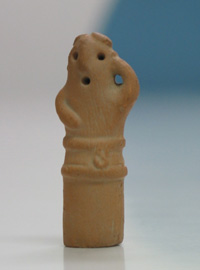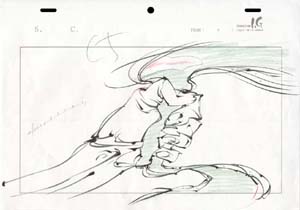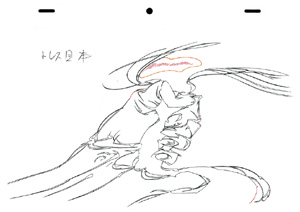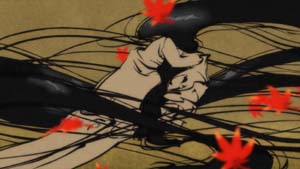The Making of Asience 4: Junko Nishimura (Inbetween Checker)
Asience: Hairy Tale is one of those little jewels Production I.G is particularly proud of. In just 60 seconds, this animated short concentrates the creative effort for one full TV episode, crafted by theatrical feature-class staff, starting from director Kazuto Nakazawa (Kill Bill: Vol. 1 animation segment) and continuing with art director Shuichi Hirata (Innocence) and music composer Yoshihiro Ike (Blood: the Last Vampire). In this multi-part special feature, we interviewed the production staff from every section, in order to offer a broader perspective about how this animation was made. In this fourth part, we introduce Junko Nishimura, a lovable sharp-tongued lady who's been collaborating with I.G since the days of Patlabor: The Movie. Nishimura vests a role that may result obscure to many animation fans: the inbetween checker. In the interview that follows, you will discover what this job is all about, and why all staff, from director Nakazawa to line producer Mitsumoto, unanimously praised her job in Asience.
 | Junko Nishimura - Veteran inbetween checker at I.G's Studio 2. She is an irreplaceable figure in the production of many of I.G's most famous titles, including Patlabor: The Movie, Patlabor: The Movie 2, Ghost in the Shell, Innocence and the openers for Blood+, noted for their unique rendering technique and extensive artistry. She is currently working on Mamoru Oshii's latest film, The Sky Crawlers. |
Can you tell us the distinctiveness of the inbetween work for this project?
As expected, the main issue was how we could render the unique brush impression. Unlike normal inbetweens, it became necessary to draw two lines for each brush stroke to recreate the original key frame. As inbetweeners can't obviously do the coloring, they had to outline each brush stroke in order to allow the digital paint section to do their job.
The key drawings were done by brush. Was it the inbetweeners who decided which line should be incorporated?
Mainly, I left them to decide, but I produced a trace sample for each sequence, just in case. The sample showed the minimum amount of lines I thought they should incorporate into the inbetweens. I wanted to recreate the original drawing as truly as possible, but at the same time, I hoped to demonstrate the "brush stroke feel," so I slightly altered it a little.
For example?
You know, when you see a line drawn with a brush, you can tell strong and weak strokes clearly. Where the brush was pressed harder, it looks kind of round, and that was easy to render. But other places where the brush was gradually lifted, the line became skinnier and I wanted it to look sharp, so I did ask to let us do the touch-up. This was done by inbetweeners where possible, so it would not require extra work later.

When you were first offered the job and saw a sample, what was your reaction?
I thought, "what a hassle." (lol) To tell you the truth, we at I.G often do these special renderings in feature films, so we keep ourselves kind of ready to handle anything that comes on our desks without panicking. (lol)
What was the challenging part, for example?
For digital paint, here at I.G we use two kind of software, Retas!Pro and Animo. Each software suite has its pros and cons. For Asience, we had some issues of how to deal with color traces and solid lines. When we were still mulling over what software to use, the inbetween section reminded me that if we were to use Animo, there might be parts where they would have to separate the color traced parts and the solid lines. I instantly demanded to the digital section people, "please don't ever put us into that situation." (lol) You see, Asience was a festival of double lines, so it was way too much to trace already.
To give you a good example, I think it was Kill Bill: Vol.1, where we had the material to be colored and covered it with a layer of penciled lines showing the shading pattern. I was so nervous we might end up doing the same for this project. Thanks heaven, they finally decided to use Retas!Pro, meaning that we had to do only one layer.
Did you meet with the director to discuss things?
Not in a precise sense. When he handed me the material, I thought, "gee, not again!" (lol) Back to the days when Kill Bill: Vol. 1 was in production, I was working on another project, so I wasn't actually with the Kill Bill team, but I could see how difficult it was to do the inbetween checks, so I already had an idea of what I was going to deal with. Let's say that I don't mind doing this type of project once a year. Well... maybe every two years... (lol)
Manual drawing seems like quite a job. Couldn't you do it digitally?
You could, but digital rendering is not really good with uneven lines and other unusual lines, so if they asked the inbetween section to add a "tarnished" effect, then I'd have to consult the digital paint section to use another tool - I mean we only have a tool called "pencil" as an option, so we have to somehow fulfill their request with pencils.

At this level of work, can you ask any inbetweener to do it?
For this project, they let me select my staff. I chose people who have done similar work before, so I wouldn't have to worry about people horrified with the assignment and yelling, "I can't do it!" Basically, I asked a couple of staff members from I.G Niigata and also some experienced staff from Studio 2, where I belong, as well as Studio 1 to do the most challenging cuts. We needed more people to tackle the workload, so I picked some rookies to do the easier parts. You never know when we might have to do something like this again. (lol) I said rookies, but I chose those I knew who were capable from among the pool of people with about a year's experience here.
According to Director Kazuto Nakazawa, he was prepared to settle with still pictures in the beginning, so when he saw that it actually moved smoothly, he couldn't believe it.
Then why didn't we use still pictures from the beginning and put them together? It was a lot of work! (lol)
We all agree it was far better to see it move.
I will explain how difficult it was. For example, in tracing, for the first trial, say it took the better part of an hour. Then the next one on, you'd think it would take half that time. Normally, yes, but for this project, even if we did the same picture over and over, we couldn't really speed it up due to the tremendous amount of lines. If the first one took about an hour, the next one would take around 50 minutes no matter how hard you worked.
Would you say the amount of time spent on one inbetween picture was twice the time you'd spend normally?
More than twice, I'd say. There were only a few straight lines, so it was also very strenuous for the hand. To accurately recreate the strong and weak strokes of the original brush painting, they had to outline the strokes with a set of two lines. And it wasn't a simple outlining job either, because the way you do it obviously determines the atmosphere of the whole picture.

Do you like a particular sequence?
I like the one where a hand grabs the hair in Cuts 7b and 18b. The movement of the lines is clear. And also when the Father goes out of the room and puffs out into the air to show the background. I think that was very hard. The storyboard didn't have any extra instructions, so you didn't know how to proceed and everything else either. The Father is basically a black mass. I made an explanatory note about his "acting performance" of turning around to leave the room. I left it up to the inbetweener about the way he disappeared. I relied entirely on Kotoe Saito of I.G Niigata to do this very difficult sequence.
It sounds like it was a challenging project. What was your impression when you saw the finished film?
Ah, such a beauty! Typical Nakazawa style. Please excuse me for saying this. I thought how very Nakazawa it was: challenging and extremely beautiful.
(4 - to be continued)
© 1994-2007 KAO CORPORATION. All Rights Reserved.

![WORK LIST[DETAILS]](/contents/works/design/images/left_title.gif)



 terms of use
terms of use